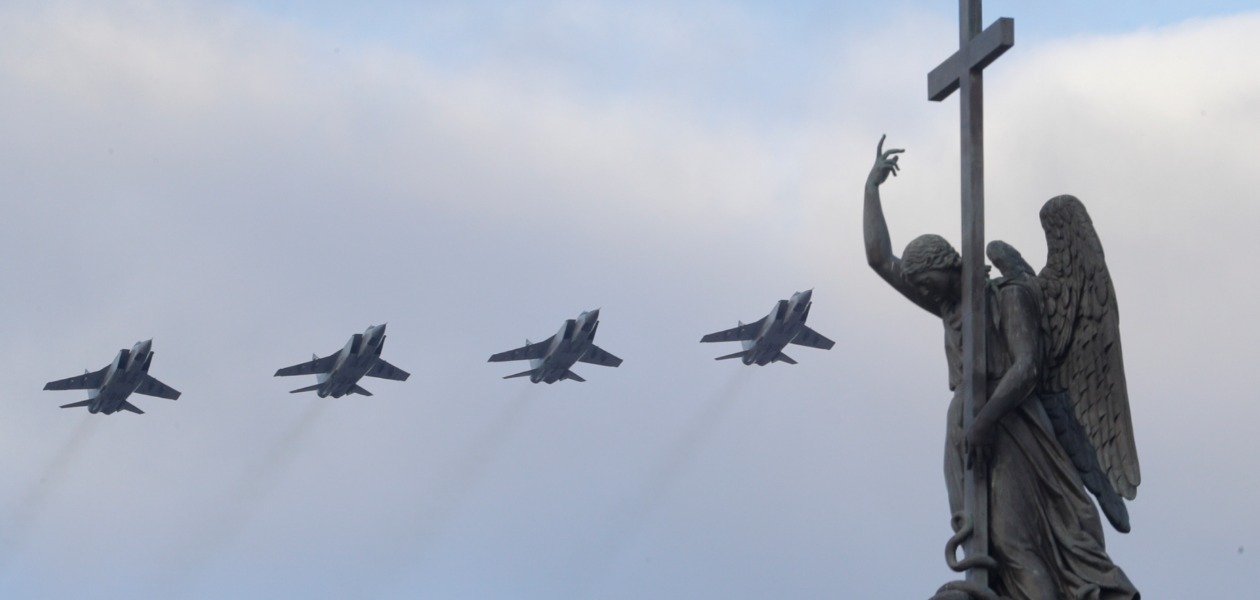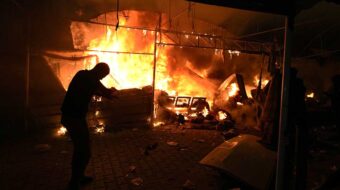
With Russian bombers raining down destruction on Ukrainian cities, the call for establishing a “no-fly zone” over the country might at first seem like a no-brainer. If Putin’s air force can be kept out of the skies, then Ukrainians might be spared the terror of death from above, right?
The proposal for a no-fly zone is getting a lot of attention right now. Ukrainian President Volodymyr Zelensky is making the pitch for one every time he has the attention of Western politicians. Many anti-war demonstrations around the world feature posters and signs demanding it. Reporters constantly pepper the White House with questions about why it’s not moving to close Ukraine’s skies.
And opinion polls show 72% of U.S. citizens—no doubt outraged by the civilian casualties in places like Kherson and Mariupol broadcast on their televisions every day—are in favor of grounding Russian planes.

While it might sound like a noble thing to do in the abstract, a NATO-enforced no-fly zone over Ukraine is actually a very, very bad idea. It would almost guarantee the start of World War III and nuclear annihilation of life on this planet.
What is a no-fly zone?
Too many foreign policy commentators and Ukrainian government spokespeople are talking about a no-fly zone like it’s something that can just be declared, as though it’s an administrative matter to be decided upon by Western states.
Zelensky has been direct in his appeals for the U.S. government to step in. Bizarrely invoking the memory of Dr. Martin Luther King, Jr.’s “I have a dream” speech, the Ukrainian president told the U.S. Congress Wednesday that he dreamed of a no-fly zone.
“Is it a lot to ask for, to create a no-fly zone over Ukraine to save people? Is this too much to ask, a humanitarian no-fly zone, [so] that Russia would not be able to terrorize our free cities?”
The day before, speaking to Canadian lawmakers, Zelensky pleaded: “Please close the sky, close the airspace, please stop the bombing…. How many more cruise missiles have to fall on our cities until you make this happen?”
Zelensky had virtually every member of Congress on their feet applauding, with Speaker Nancy Pelosi cheering the right-wing battle cry, “Slava Ukraini!” But only a handful of U.S. politicians appeared to be won over to the idea of a no-fly zone. Florida Sen. Rick Scott was one; he said President Joe Biden is “heartless and ignorant” if he doesn’t “close Ukrainian skies to Russian attacks.”
Zelensky would have us believe that Washington or Ottawa can simply issue a statement saying Ukraine’s skies are closed, and then, like magic, the Russian military will halt its air assault. Sen. Scott says anyone who opposes it is ignorant. But it is the advocates of a no-fly zone who are the ignorant ones.
The reality is that enforcing a no-fly zone would literally mean that NATO (which basically implies U.S.) warplanes and missiles would be shooting down Russian planes—American military personnel killing Russian military personnel.
That would mean war—immediate war between Russia and the 30 nations of the U.S.-dominated NATO alliance. And a war between Russia and the United States could very easily escalate to an all-out nuclear confrontation. Russia already put its nuclear forces on high alert before the invasion of Ukraine and warned others to stay out, and U.S. missiles are always ready to launch at a moment’s notice.
No one should underestimate the consequences at stake.

A nuclear war between Russia and the United States would mean hundreds of millions of people dead within hours, or even minutes. Washington, New York, Los Angeles, Chicago, Moscow, St. Petersburg, Kiev, London, Paris, Berlin, and so many more cities would be wiped off the map. In such a nuclear exchange, it would probably also be hard to keep other nuclear powers from being dragged in, so Beijing, Shanghai, Taipei, and various metropolises far removed from the war zone could also be vaporized.
Some voices in the media, well aware of what a no-fly zone would risk, are willing to gamble the future of humanity. Sam Bowman, editor of the publication Works in Progress and former executive director of the Adam Smith Institute, a capitalist think tank, wrote on Twitter on March 14:
“My view is basically that nuclear war is worth risking for some things, like keeping as much of Europe free and independent of Russia as we can. But I think that’s a hard position to hold if you think the extinction of humanity is so bad that avoiding it trumps everything else.”
God save the free market, everything else be damned—so goes the logic apparently.
Luckily, Biden, other NATO leaders, and most in the U.S. Congress recognize the reality that if there is a nuclear war, there won’t be any Europe, any free markets, any humanity, or anything else left—and so they continue to resist calls for a no-fly zone, so far.
When many people hear about a no-fly zone, perhaps they have memories of Iraq in the 1990s or the Bosnian war amid the breakup of Yugoslavia that same decade. Leaving aside the legality of those wars for now, the situations in those places are not comparable to what’s unfolding in Ukraine right now. In those cases, the U.S. had a total military advantage in comparison to Saddam Hussein or the Bosnian Serbs.
Neither of the U.S.’ adversaries in those 1990s conflicts could match it in weaponry, and neither possessed a nuclear capability. If an Iraqi or Serbian plane was shot down, or vice-versa, if a U.S. plane was shot down, there was little likelihood that those wars would automatically and drastically spin out of control into other countries.
Mutually Assured Destruction
By contrast, a direct confrontation between U.S. and Russian pilots over Ukraine, or the destruction of a Russian bomber by an American missile, would immediately drag us all into a much wider war that no one could win.
During the Cold War, both the USSR and the United States acknowledged that both countries would be destroyed if either of them ever initiated a nuclear war. That awareness was called M.A.D.—Mutually Assured Destruction—and it kept the world safe, though there were more than a few close calls over the years.
U.S. President Ronald Reagan and Soviet leader Mikhail Gorbachev met in 1985 and declared to the world, “A nuclear war cannot be won and must never be fought.” That principle should be central to all discussions of a no-fly zone right now, and it should put to rest any notion that one should be enforced.

Russia’s invasion of Ukraine, the heavy civilian casualties it is causing, and Putin’s order to put his country’s nuclear forces on high alert have made this a dangerous moment. But the United States, too, has taken many provocative steps which brought us to this precipice.
In 2002, reversing decades of nuclear arms control progress, President George W. Bush pulled the U.S. out of the landmark 1972 Anti-Ballistic Missile Treaty. His successor, Barack Obama, moved along two tracks, negotiating a New Strategic Arms Reduction Treaty (New START) with Russia while also spending billions upgrading the capabilities of the U.S. nuclear arsenal. Then, under Donald Trump, the U.S. left the 1987 Intermediate-Range Nuclear Forces (INF) Treaty. Today, U.S. missiles are deployed to Poland and the Czech Republic, not far from the Russian border.
The progress that was previously made toward reducing the nuclear war danger has been eroded. This is a major part of the context through which calls for a no-fly zone in Ukraine must be evaluated. Many of the backstops to prevent global nuclear destruction have already been removed, so we can’t afford to take any risks.
Negotiations now, not nuclear annihilation
The people of Ukraine are now caught up in the middle of a conflict between great powers. They’re paying the most immediate cost of this fight, with thousands losing their lives. The rest of the globe is now also subjected to the risk of a new world war.
U.S. imperialism, determined to encircle Russia and cement its dominance in Europe, helped overthrow the government of Ukraine in a coup in 2014 and dangled the prospect that the country would be brought into the anti-Russia NATO military alliance. The coup empowered the extreme right wing in Ukraine and helped set off a civil war in the east that raged for over eight years.

The ruling clique around Putin was certainly provoked by many years of escalating U.S. threats to Russian security, but it also has its own agenda. Dreams of a new Russian empire that will bring old subjects back under Moscow’s rule and reverse Soviet-era openings for national self-determination are a key motivation, judging by the Russian president’s own speech on the eve of the Ukraine invasion.
Old Czarist Russia, before the time of the Communist revolution of 1917, was known as the “prison house of nations.” It is that past which Putin seems determined to resurrect.
Russia must halt its offensive and recognize Ukraine’s right to exist. Ukrainian authorities must enter into serious dialogue on the questions of military neutrality and resolution of the civil war in the Donbass regions of Donetsk and Lugansk, including bringing fascist and neo-Nazi elements in the armed forces under control. NATO must pledge not to seek expansion into Ukraine. And the U.S. must stop pumping the region full of weapons and troops.
To save the people of Ukraine and to save the world from a global war, negotiation is the only realistic path ahead. A no-fly zone, however noble some may think it sounds, is not the solution to the terrors now being visited upon Ukrainians. Indeed, a no-fly zone is the quickest way to ensure the extinction of Ukraine—and the rest of us—from the face of the Earth.












Comments